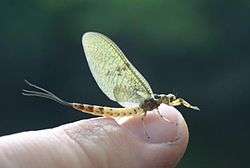Definify.com
Definition 2025
蜉蝣
蜉蝣
Japanese

蜉蝣 (kagerō, fuyū): a mayfly.
Etymology 1
| Kanji in this term | |
|---|---|
| 蜉 | 蝣 |
| Hyōgaiji | Hyōgaiji |
| Irregular | |
Change in meaning from 陽炎 (kagerō, “heat haze, heat shimmer”), from the way that the insects fly in swarms that visually resemble heat haze.[1]
Pronunciation
- (Irregular reading)
- (Tokyo) かげろう [kàgéꜜròò] (Nakadaka - [2])[2][3]
- (Tokyo) かげろう [kàgéróó] (Heiban - [0])[2][3]
- IPA(key): [ka̠ɡ̃e̞ɺ̠o̞ː]
Alternative forms
- 蜻蛉 (obsolete)
Noun
蜉蝣 (hiragana かげろう, katakana カゲロウ, romaji kagerō, historical hiragana かげろふ)
Usage notes
As with many terms that name organisms, this term is often spelled in katakana in biological contexts, as カゲロウ.
Idioms
Etymology 2
| Kanji in this term | |
|---|---|
| 蜉 | 蝣 |
| Hyōgaiji | Hyōgaiji |
| Irregular | |
Change in meaning from 陽炎 (kagirō, “heat haze, heat shimmer”), from the way that the insects fly in swarms that visually resemble heat haze.[1]
Obsolete reading.
Alternative forms
- 蜻蛉 (obsolete)
Noun
蜉蝣 (hiragana かぎろう, romaji kagirō, historical hiragana かぎろふ)
- (obsolete) dragonfly
Etymology 3
| Kanji in this term | |
|---|---|
| 蜉 | 蝣 |
|
ふ Hyōgaiji |
ゆう Hyōgaiji |
| on'yomi | |
From Middle Chinese compound 蜉蝣 (bjuw yuw?, literally “mayfly + mayfly”). Compare modern Mandarin 蜉蝣 (fúyóu, “mayfly”).
Pronunciation
- On'yomi
- (Tokyo) ふゆう [fùyúú] (Heiban - [0])[2]
- (Tokyo) ふゆう [fúꜜyùù] (Atamadaka - [1])[2]
- IPA(key): [ɸɯᵝjɯᵝː]
Noun
蜉蝣 (hiragana ふゆう, romaji fuyū, historical hiragana ふいう)
- mayfly
- ephemerality (by extension from the way that mayflies are born and die within a day)
Idioms
References
- 1 2 1988, 国語大辞典(新装版) (Kokugo Dai Jiten, Revised Edition) (in Japanese), Tōkyō: Shogakukan
- 1 2 3 4 2006, 大辞林 (Daijirin), Third Edition (in Japanese), Tōkyō: Sanseidō, ISBN 4-385-13905-9
- 1 2 1998, NHK日本語発音アクセント辞典 (NHK Japanese Pronunciation Accent Dictionary) (in Japanese), Tōkyō: NHK, ISBN 978-4-14-011112-3